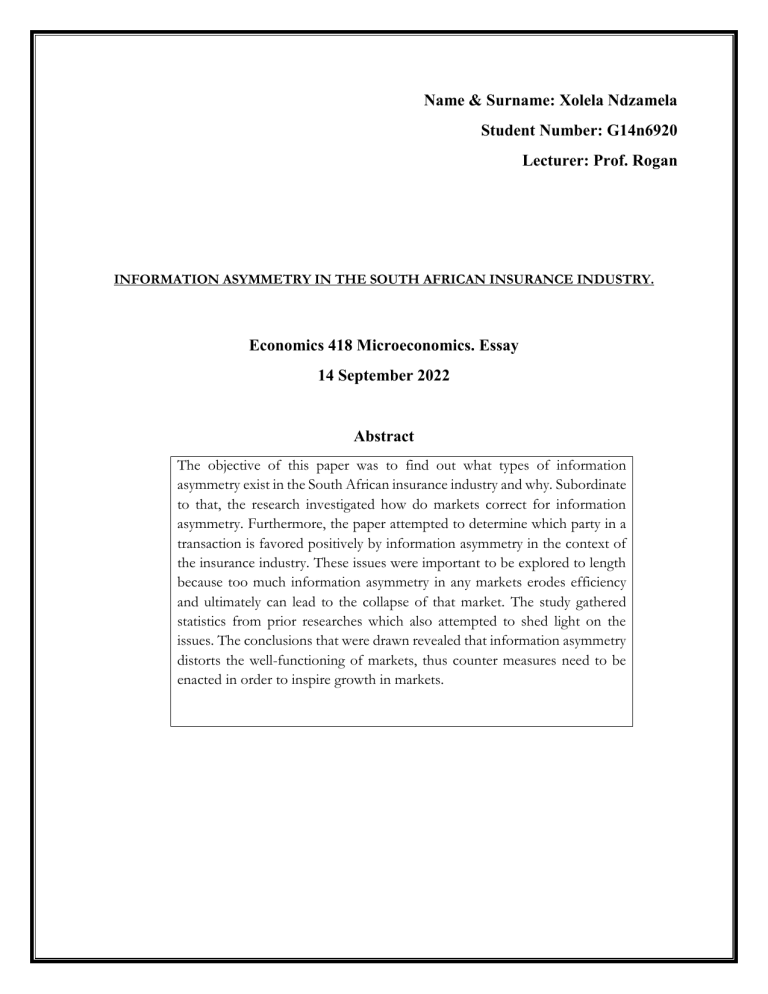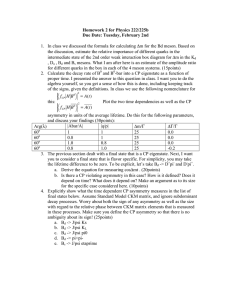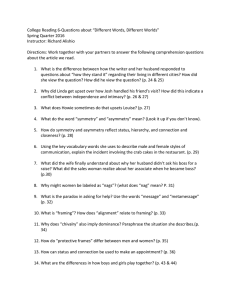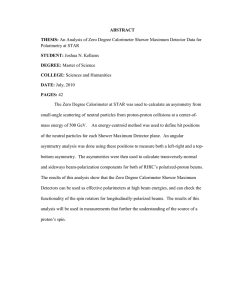
Name & Surname: Xolela Ndzamela Student Number: G14n6920 Lecturer: Prof. Rogan INFORMATION ASYMMETRY IN THE SOUTH AFRICAN INSURANCE INDUSTRY. Economics 418 Microeconomics. Essay 14 September 2022 Abstract The objective of this paper was to find out what types of information asymmetry exist in the South African insurance industry and why. Subordinate to that, the research investigated how do markets correct for information asymmetry. Furthermore, the paper attempted to determine which party in a transaction is favored positively by information asymmetry in the context of the insurance industry. These issues were important to be explored to length because too much information asymmetry in any markets erodes efficiency and ultimately can lead to the collapse of that market. The study gathered statistics from prior researches which also attempted to shed light on the issues. The conclusions that were drawn revealed that information asymmetry distorts the well-functioning of markets, thus counter measures need to be enacted in order to inspire growth in markets. Introduction The insurance industry in Africa is worth around $68 billion with respect to the gross written premiums (GWP) and globally it is the 8th biggest, despite this, it is not evenly spread throughout the continent (Bagus, Jurd de Girancourt, Mahmood and Manji, 2020)1. Markets differ in their size, composition, extent of consolidation and development, in Africa 10 nations account for 91 % of all premiums. According to Bagus et. al (2020) South Africa, the most established and largest insurance market, in total accounts for 70% of premiums in the continent2. Despite having such a significant market share in contrast to other African nations SA’s insurance industry has been seemingly heading downhill. Prior to the country even going into full lockdown due to the COVID-19 epidemic, SA's insurance industry was already struggling with a financial crisis and a fall in credit ratings. Some experts proposed part of the factors which are a driving force to the sector's decline are an increase in insurance crime and fraud. This typically arises when a policyholder or claimant makes a bogus claim to a provider of insurance in order to acquire some type of financial advantage or benefit (South African Insurance association, 2020) 3. This is made possible because there is an "imbalance of information" between the parties involved in the transaction. Both transacting parties are cable of producing an imbalance of information, however the scale and ease at which they can do it can differ. Insurance firms can produce an "imbalance of information," which can result in a loss for the insured. For instance, Insurance providers, as the architects of insurance contracts (mostly short-term), frequently insert conditions in insurance contracts that haven't been revealed to the insured as incidentalia 4. If these were revealed in general terms, they were generally not clarified in depth. Similarly, consumers of insurance can refrain from furnishing the insurance provider with information that might be important in determining the price of the premiums. As a result of this information imbalance, a problem known as information asymmetry arises. According to Ruan (2019), information asymmetry in insurance refers to a circumstance in which the market fails because one participant to a transaction lacks adequate knowledge regarding the other participant. This article investigates whether information asymmetry is extremely concentrated or somewhat weak within the business of interest using the insurance industry. This is accomplished through the use of data/statistics and a thorough examination of prevalent economic ideologies. The study then examines the many sorts of information asymmetries that may arise and attempts to explain why these may exist. Furthermore, because markets are always developing, the research investigates how markets compensate for the presence of information asymmetry. Before concluding, the paper considers which parties to a transaction profit from information asymmetry. 1 Gross written premiums refer to the total premium (direct and assumed) written by an insurer before deductions for reinsurance and ceding commissions. 2 See how South Africa’s GWP compare to that of other regions in Africa, this is shown in Figure 1 in the appendix. 3 In South Africa the results for insurance fraud are consistent with global trends and data, which suggested that 32 percent of all claims made in the country's insurance sector were false in 2018 (South African Insurance Association, 2020). 4 See Fliptrans CC v S & P Insurance Advisors (Pty) Ltd t/a McCrystal and Partners drawing from this case, the covered car in this instance was not equipped with a GPS tracker. The Ombud concluded that the omission by the insurance company to educate the plaintiffs about the specific requirement of attaching a GPS tracker was the cause of the complainants' losses. As a result, the source of the information imbalance was the insurer, it withheld material information from its client which eventually resulted in an unfavourable loss for the client. Theoretical framework and application to the South African context. The insurance industry is one domain that is notably plagued with information asymmetry. According to Aygen (2005) when transacting in the insurance industry, there are two major concerns that might occur as a result of information asymmetry. These include adverse selection and moral hazard. Adverse selection Adverse selection is known as the difficulty that develops when a corporation (or individual) decides to insure against a certain loss and has private knowledge that the insurance provider does not possess at the time of the agreement (Chiappori and Salanié, 2013). This occurs when someone takes full advantage of information asymmetric prior to a transaction. For instance, in the court case B v. Hollard Life Insurance, Elizabeth Maria Basson (plaintiff), was the recipient of a policy for life insurance that her late husband (the "Deceased") had purchased before his passing. After the Defendant (Hollard Life Assurance Company) denied the claim due to the alleged misrepresentation by the Deceased's and failure to disclose material facts to the insurance company prior to the agreement of the policy was reached. the Plaintiff filed a lawsuit against Hollard Life Insurance, to receive the payment of the policy's proceeds 5. The deceased had not revealed the following facts which are the four reasons for non-disclosure: firstly, he suffered from circulation or heart issues; secondly, he had a respiratory or lung problem; thirdly, he battled depression; and lastly that a prior request for insurance coverage on the Deceased's life was turned down. The above-mentioned misrepresentation and nondisclosure transpired during the time of the insurance policy's conclusion, resulting in adverse selection. As a result, the insurance company could not accurately price the premiums due to its inability to view some important information about the insured. Riskier clients are associated with higher premiums as compared to healthier individuals. The inability of the insurer to price risk appropriately due to an imbalance in information harmfully amounts to the business losing potential revenue. This therefore forces the corporation, in order to stay afloat, to pass these expenses along to every client, which makes markets inefficient. The provided service will not correspond to the anticipated advantage6. Moral hazard Moral hazard is another issue that insurance firms encounter. This occurs when one participant in a trade has information asymmetry after the contract has been concluded (Alhassan and Biekpe, 2016). In other words, the consumer of an insurance service could act in a way that changes the risk stated in the contract (Arvidsson, 2010). As a result, after purchasing insurance, the policyholder makes less of an effort to prevent accidents and increases their risk. The rationale for this is that the insurance firm bears the most of the economic risk. For instance, Ehrlich and Becker (1972), predicted that health insurance would lessen people's (unobserved) effort to preserve their health. Since health insurance pays for a portion of the monetary expenditures brought on by unhealthy behaviors. As a result, when people have insurance, they might smoke more, eat more cheeseburgers and exercise less. In a similar vein, having fire insurance might possibly encourage arson. 5 see B v Hollard Life Insurance (2014/10011) [2018] ZAGPJHC 460; [2018] 4 All SA 77 (GJ) (16 April 2018) The fact is that if bogus claims are granted, the additional expenses will have a detrimental impact on honest consumers' premiums. The average premium in the insurance industry will increase. Consequently, the expected risk of honest customers will tend to command a higher premium too even though their behaviour might have remained the same. 6 Particularly if the owners are running a failing firm and determine that the money from the insurance payouts will create far more value going forward than the buildings themselves. Reasons why information asymmetry exist in the insurance industry. A common assumption in economics is that market players have "perfect information," upon which they make their decisions (Okuyan, 2014.). Additionally, it is further assumed that there is perfection competition in markets (insurance). In reality, however, these assumptions fail to hold. Transacting parties cannot possibly know everything there is to know about every transaction. Therefore, the existence of imperfect information gives transacting parties an opportunity to act in a manner that best safeguards their interest. In the insurance industry, it has been observed covered people or businesses are a major source of information asymmetry. This is because it is less expensive for people who are covered to avoid giving information that may raise their premiums. whereas it is expensive for firms to enact measures to observe unwanted behaviors. Due to this failure to share important knowledge, an information imbalance comes to existence and hence information asymmetry. Consumers of insurance, according to consumer choice theory rationally behave in a fashion that maximizers their utility (Aleskerov, Bouyssou and Monjardet, 2007). Hence, it is not out of the ordinary to expect an individual with a car insurance to engage in risky driving that maximizes their utility for a given level of premiums they pay. Also, apart from the need to maximize utility another reason why information asymmetry exists is motivated by the desire to obtain a monetary gain. For instance, if the policyholder is hospitalized for three days or more, Assupol health cover promises to pay between R500 and R5000 each day (Assupol, 2022). This can encourage people to forgo leading healthy lifestyles. Thereby giving rise to the existence of information asymmetry. Ways in which markets correct for information asymmetry: adverse selection. Information asymmetry is a challenge that all markets face including insurance (Chiappori, Jullien, Salanié, and Salanie, 2006.). Nevertheless, given the variety of strategies employed by insurance firms to address these information asymmetries, many markets operate satisfactorily. Many of these solutions were created as a consequence of experience accumulated over time, and they have contributed to the effective insurance markets we have nowadays. Signaling and screening can be used to minimize adverse selection (Riley, 2001). Insurance providers utilize "screening" techniques to distinguish between high- and low-risk individuals. Screening is a technique for preventing unfavorable selection by weeding out erroneous information and keeping just the factual information (Riley, 2001). With the use of screening, businesses may impose a premium that is reasonable for the risk taken 7. Insurance firms utilize a variety of methods to screen applicants. While not limited to these, firstly insurers review a client’s historical records. When assessing the amount of risk and likelihood that a customer may participate in hazardous activity in the future, insurance companies consider the client's prior behavior. A customer is more likely to be engaged in the future in an accident if, for instance, they have a history of having many car accidents. It alerts the insurance firm to the degree of risk it is taking by giving car insurance to the dangerous client. Secondly, insurance companies can check a person's health status. The health status and types of sicknesses a customer has will be important information to the insurance firm when giving life insurance coverage. Clients 7 Due to this endeavour to generate symmetry in information, insurers can partially observe the risk characteristics of their clients with some degree of precision. This can have a favourable impact on the insurance industry since markets will become more efficient and hence competitive. Competitive markets have the advantage of offering high-quality goods and services at a reasonable price. with incurable diseases or other chronic illnesses are typically viewed as riskier and are thus subject to higher rates than clients without a medical history of illness. Thirdly, examining the demographics of potential customers is another factor that insurance firms take into account. When selling vehicle insurance, younger customers in the age range of 13 to 20 are viewed as riskier than customers between the ages of 40 and 50. In contrast, life insurance companies view elderly consumers above the age of 60 as riskier than younger clients between the ages of 30 and 40. Similar to screening, signaling occurs when the participant with the most knowledge chooses to move first to distinguish themselves as a participant acting in good faith (Eckardt, 2007). Insurance-related services are quite complicated. Before making a purchase, buyers find it challenging to accurately judge their qualities. Signaling theory demonstrates that there are techniques for companies to credibly indicate that they deliver high quality services. The most often employed signals are licensing and certificates, investments in reputation, cheap introductory prices, warranties or guarantees, and advertising (Eckardt, 2007). For example, OUTsurance, a South African firm, pays potential consumers R500 if they can't offer a better premium than their existing car insurance premium! Additionally, if a new client has had the same insurance for three years without filing a claim, they will give the new client R1500 (OUTsurance, 2022). This is a clear indicator that they are signaling to prospective consumers their capacity to supply inexpensive insurance. The use of signaling theory demonstrates how companies that offer higher-quality services (or goods) can decrease the effects of adverse selection thus reducing information asymmetry Ways in which markets correct for information asymmetry: Moral hazard. The use of incentives, co-payments, deductibles, and partial coverage are some of the methods that insurance companies might use to limit moral hazard to some extent. A deductible is a clause that requires the policyholder in an insurance policy to cover the first costs of damages up to a certain amount (Katz and Rosen, 1998). The word "excess" is much more commonly used to describe this. A co-payment is a clause that requires the policyholder in an insurance policy to pay a portion of the cost for damages in the event that a claim arises (Katz and Rosen,1998). The question therefore becomes, what form of prevention method should an insurance business use to cope with moral hazard? This varies depending on the circumstance it is in. Deductibles are the best option for the insurance firm if the moral hazard is the kind that would probably raise the chance of a loss. This is to the fact that using a deductible saves the insurance firm cash not just by promoting higher care but also by lowering the expense of dealing and processing minor claims (Tumay, 2009). The insurer should pick co-payments if moral hazard would raise the magnitude of the settlement. This is such that the co-payment is higher the more loss the insured sustains. Therefore, there is an incentive for covered parties to minimize the extent of the loss. A much more appealing method of discouraging moral hazard to many individuals consuming insurance services is the use of incentives. A popular market solution is to draft contracts that give incentives. For instance, if a driver has a clean driving record and has not made any claims in the last few years, the car insurer may reduce the premiums. The ultimate beneficiaries of information asymmetry in the insurance industry In markets like the insurance sector, asymmetric information favors buyers, however in markets like real estate, stocks and used cars sellers typically have more knowledge than buyers. There are a number of reasons as to why consumers enjoy the “lion’s share” in terms of benefits in the insurance industry due to the existence of insurance asymmetry. One of the reasons is that it is expensive for insurance firms to keep track of every person's behavior after the contract is signed. This gives the insured an unmatched degree of freedom to engage in any actions that could potentially benefit them (financially), such as staging accidents, killing people for insurance, and so on in order to cash in. Additionally, when money is less of a motivating factor, an insured person can benefit from participating in activities that increase their utility, such as car racing for those with car insurance. As a result, the insurance business suffers since the risk absorbed does not correspond to the premiums that these people are paying. The act of the insured acting exclusively to profit themselves while disadvantaging the other party is now on the rise in South Africa. According to the Association for Savings and Investment South Africa (2021) throughout all areas of risk business, life insurers in South African discovered 4 287 dishonest and fraudulent claims totaling R787,6 million in 2021. In comparison to 2020 this is a substantial rise, when 3 186 instances of dishonest and fraudulent claims totaling R587.3 million were discovered. Furthermore, according to the Association for Savings and Investment South Africa (2021) dishonest and fraudulent claims figures for 2021, reveal that funeral insurance drew the greatest rate of dishonesty and fraud, trailed by cover for death, cover for disability, hospital cash plans, and lastly benefit cover for retrenchment. In order to get a bigger picture of the composition of the claims constituting funeral fraud and the provinces with the most insurance fraud statistics, data has been presented in figure 2 and 3 in the appendix. Conclusion The problem of information asymmetry is said to arise from an imbalance of information shared between the transacting parties. Both transacting parties can be sources of information asymmetry, however in the insurance market, insurance consumers are the ones that contribute the most to this problem. The insurance sector is characterized by two forms of information asymmetry. The first is adverse selection, which happens when a party to a transaction has information asymmetry prior to the contract's conclusion. The second is moral hazard, which happens when a party to a transaction has information asymmetry after the contract is signed. The presence of this information asymmetry is due to the fact that, contrary to what economic theory claims, consumers do not possess perfect information and markets are not perfectly competitive. As a result of market imperfections that are observable in reality, market efficiency is eroded. Firms have devised solutions to mitigate the impact of these imperfections. Screening and signaling in the context of adverse selection are two of the remedies for reducing information asymmetry. In the event of moral hazard, the use of incentives, co-payments, deductions, and partial coverage might drive individuals to manage their risk. Despite the fact that these procedures are in place to mitigate the effects of information asymmetry, there are still winners and losers owing to the current imperfect competition. Consumers of insurance, in particular, tend to reap the "lion's share" of advantages emerging from information asymmetry in the insurance industry. Appendix Figure 1: South Africa’s Gross written premium in comparison to other African regions Source: (South African Insurance association, 2020) Figure 2: The area with the most fraudulent in the insurance sector in South Africa Source: (Association for Savings and Investment South Africa, 2021) Figure 3: Dishonest and fraudulent claims cross all provinces Sources: (Association for Savings and Investment South Africa, 2021) List of references ALHASSAN, A.L. and BIEKPE, N. 2016. Competition and efficiency in the non-life insurance market in South Africa. Journal of Economic Studies. ARVIDSSON, S. 2010. Essays on asymmetric information in the automobile insurance market (Doctoral dissertation, Örebro universitet). ASSOCIATION FOR SAVINGS AND INVESTMENT SOUTH AFRICA. 2021. Life insurers uncover record numbers of fraudulent and dishonest claims in 2021. [online]. Available: https://www.asisa.org.za/media-releases/life-insurers-uncover-record-numbers-of-fraudulent-and-dishonestclaims-in-2021/ [Accessed 11 September 2022]. ASSUPOL. 2022. Health plus benefit from Assupol. [online] Available: https://assupol.co.za/media/nkroyzxl/health-flyer_.pdf [Accessed 14 September 2022]. AYGEN, M.F. 2005. An examination of Turkish insurance industry in light of information asymmetry (Master's thesis, Middle East Technical University). BAGUS, U., JURD DE GIRANCOURT, F., MAHMOOD, R. and MANJI, Q. 2020. Africa’s insurance market is set for takeoff. [online]. Available: https://www.mckinsey.com/featured-insights/middle-east-and-africa/africas-insurance-market-is-set-fortakeoff [Accessed 12 September 2022]. CHIAPPORI, P.A., JULLIEN, B., SALANIÉ, B. and SALANIE, F. 2006. Asymmetric information in insurance: General testable implications. The RAND Journal of Economics. 37 (4):783-798. CHIAPPORI, P.A. and SALANIÉ, B. 2013. Asymmetric information in insurance markets: Predictions and tests. Handbook of insurance. 24 (6): 397-422. ECKARDT, M. 2007. Does signaling work in markets for information services? An empirical investigation for insurance intermediaries in Germany (No. 77). Thünen-Series of Applied Economic Theory-Working Paper. Ehrlich, I. and Becker G.S. (1972). “Market insurance, Self-insurance, and Self-protection.” Journal of Political Economy. (80): 623–648. EINAV, L. and FINKELSTEIN, A. 2018. Moral hazard in health insurance: what we know and how we know it. Journal of the European Economic Association, 16 (4): 957-982. KATZ, M.L. and ROSEN, H.S. 1998. Microeconomics. Boston-Mass: Irwin McGraw-Hill. OKUYAN, H.A. 2014. The effect of asymmetric information on turkish banking sector and credit markets. Revue économique. 65 (5): 699-708. OUTsurance. 2022. OUTsurance | Save on car insurance or ask for R500. [online]. Available: https://www.outsurance.co.za/car-insurance/r500promo/ [Accessed 10 September 2022]. RILEY, J.G. 2001. Silver Signals: Twenty-Five Years of Screening and Signaling. Journal of Economic Literature. 8 (39): 432- 478. RUAN, K. 2019. Digital asset valuation and cyber risk measurement: Principles of cybernomics. Academic Press. South African Insurance Association. 2020. PROMOTING A TRUSTED, A SUSTAINABLE NON-LIFE INSURANCE INDUSTRY FOR SOUTH AFRICA. [online]. Available: https://www.saia.co.za/index.php?id=2208 [Accessed 11 September 2022]. TUMAY, M. 2009. Asymmetric information and adverse selection in insurance markets: The problem of moral hazard. Yönetim ve Ekonomi. 16 (1): 107-114.




